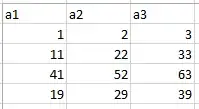I have lots of text documents structured as
{
{
Item1=[
{a1=1,
a2=2,
a3=3},
{a1=11,
a2=22,
a3=33},
{a1=41,
a2=52,
a3=63},
{a1=19,
a2=29,
a3=39}
],
Item2=[
{a4=1,
a5=2,
a6=3},
{a4=11,
a5=22,
a6=33},
{a4=41,
a5=52,
a6=63},
{a4=19,
a5=29,
a6=39}
],
}
}
Now this can be formatted into two csv's as
and
I can write regex parser for this but is there a way by which a neural network or deep learning model can be trained for this, which can create these csvs?
The above example has been indented for better visuals, the raw text looks something like
{{Item1=[{a1=1,a2=2,a3=3},{a1=11,a2=22,{a1=41,a2=52,a3=63},{a1=19,a2=29,a3=39}],Item2=[{a4=1,a5=2,a6=3},{a4=11,a5=22,a6=33},{a4=41,a5=52,a6=63},{a4=19,a5=29,a6=39}]}}

